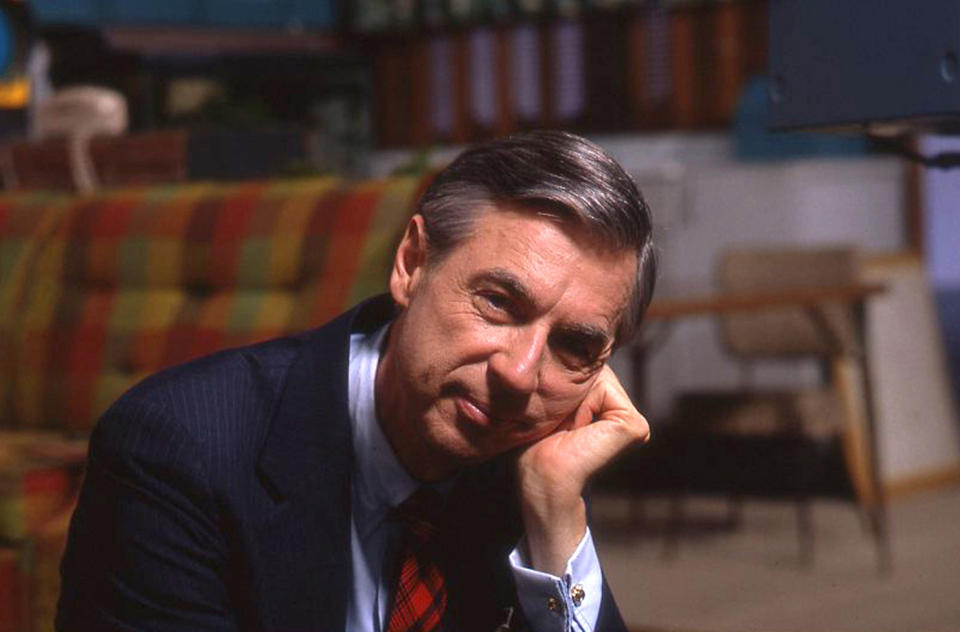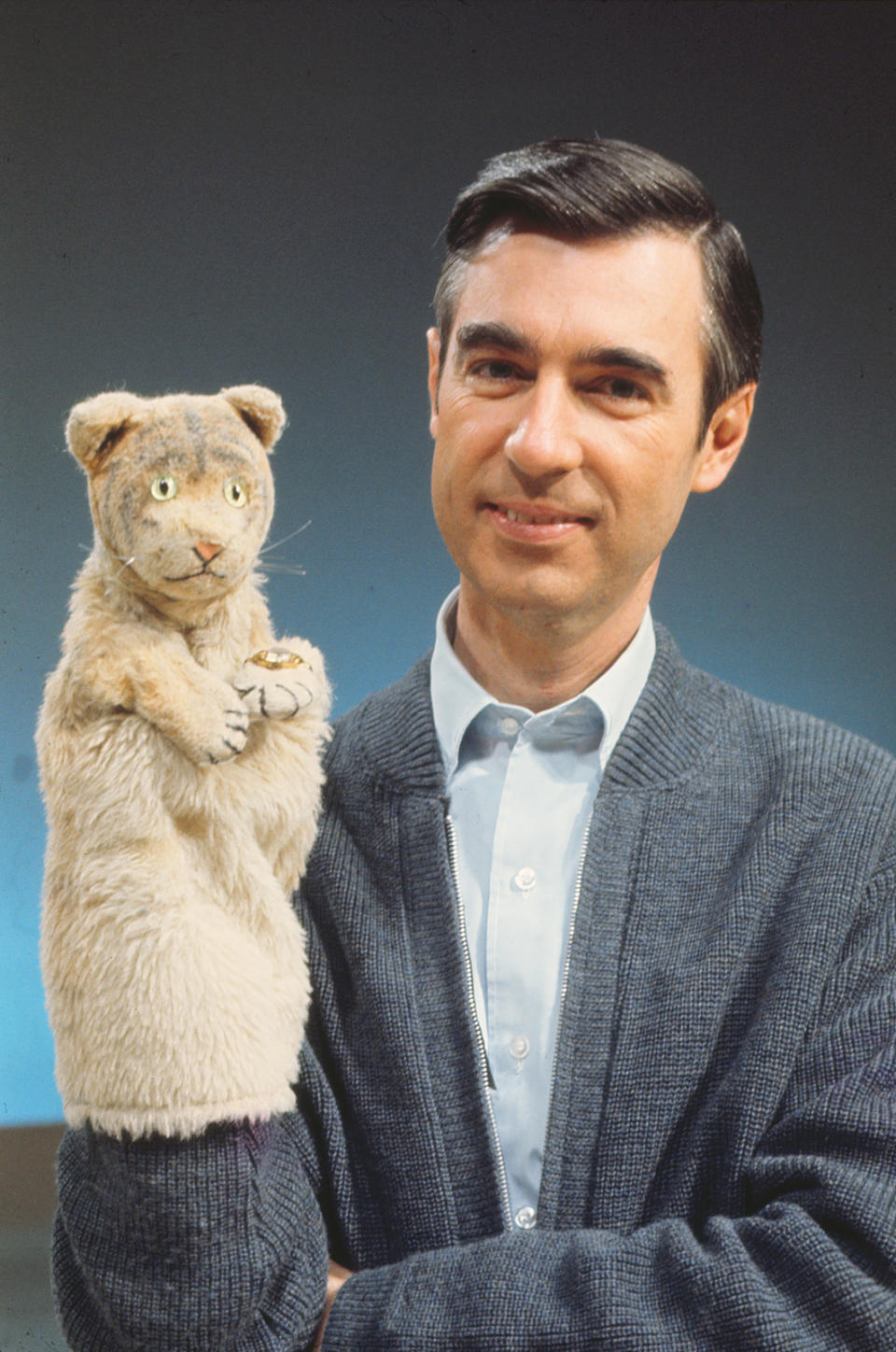5 things you didn't know about Mister Rogers, from Bob Marley fandom to 'Living Dead' connection
As the host of the long-running PBS series Mister Rogers’ Neighborhood, Fred Rogers made a point of establishing a direct personal relationship with each and every child who visited his own ‘hood via the television screen. Regular viewers of the series — which includes pretty much every kid born between 1968 and 2001 — knew that the Pennsylvania native, who died in 2003, liked his sweaters, his trains, and his Land of Make Believe. But there are aspects of his life that Mister Rogers never publicly revealed on public television. Some of those details are disclosed for the first time in Morgan Neville’s acclaimed documentary Won’t You Be My Neighbor?, a moving portrait of Rogers’s life and career that’s playing in theaters now.
The Oscar-winning director of 20 Feet From Stardom spent a year and a half immersing himself in vintage episodes of Mister Rogers’ Neighborhood — some of which he saw as a child himself when they originally aired — and spoke with his subject’s friends and family. As he tells Yahoo Entertainment, he emerged from that deep dive with a new appreciation for Rogers’s unique place in pop culture. “I never met Fred Rogers, but in a weird way I feel I knew him, because he always spoke to a single child on the other side of the lens. My memories of the show are really more emotions, and making the film was a chance to revisit that part of myself I hadn’t spent time with in a very long time.” Watch the above video and read on to learn five things you probably never knew about your favorite TV neighbor.
Mister Rogers was a big Bob Marley fan
Though he was an accomplished musician, Rogers’s on-screen musical tastes were often limited by his show’s toddler demographic. In his own life he liked to be more adventurous, and he often turned to his sons, Jim and John, to suggest new artists, both as a way to explore new sounds and to remain connected with them as they grew older. “I do think Fred Rogers was a lot better speaking to young kids than teenage boys coming of age in the 1970s,” Neville says, chuckling. “Jim told me a great story: Fred was trying to stay in touch with his teenage boys, and his sons would give him mixtapes of what they were listening to.” Through those mixtapes, Rogers was turned on to cutting-edge artists like Frank Zappa and, especially, reggae legend Bob Marley. “If you think about it, the message of Bob Marley — this Rastafarian ‘One Love’ idea — is very much in line with Mister Rogers. Though his son did tell us, ‘Of course I didn’t give him the ganja songs!'”

Zombie mastermind George Romero spent time in Mister Rogers’s neighborhood before getting into zombies
You might think that a G-rated entertainer like Fred Rogers would have next to nothing in common with horror guru George Romero apart from a Pittsburgh ZIP code. But you’d be wrong! According to Neville, Rogers and Romero were good friends, and the director even worked as a cameraman for Mister Rogers’ Neighborhood prior to single-handedly creating the contemporary zombie genre. “Before he made Night of the Living Dead, he said that the scariest thing he ever shot was [the field piece] ‘Mister Rogers Gets a Tonsillectomy.'” Even after he struck out on his own, Romero kept in touch with his early employer and invited him to early screenings of his films to get his input. “In a way, what George Romero was doing with his zombie movies were these allegories on race and consumerism, and what Fred was doing was allegories on race and consumerism and all these other social issues. In their own way, they were using a certain type of genre to explore a much deeper issue.”
That time Mister Rogers welcomed Big Bird to his neighborhood
For more than three decades, the twin pillars of PBS children’s programming were Mister Rogers’ Neighborhood and Sesame Street, which launched within a year of each other in 1968 and 1969, respectively. And according to Neville, Rogers initially had conflicted feelings about his sister show. “If you look at the early seasons of Sesame Street, it’s incredibly fast-paced. Fred had big problems with it, and there was a quiet internal discussion with PBS. He was approaching it from a child-development background, and they were approaching it from a marketing background, thinking about what works in TV. Fred ended up getting to know the Sesame Street producers, and the show actually slowed down because of him.”
Once they were on the same speed, so to speak, Rogers became a big proponent of Sesame Street, making a famous crossover appearance on the series, and inviting its most flagship character, Big Bird, to visit his neighborhood. But that invitation came with an important stipulation. If the plus-size fowl was going to sit across from Mister Rogers in his home, he’d have to take his oversize head off and reveal the man — puppeteer Caroll Spinney — beneath. “Fred liked to demystify things,” Neville explains. “He thought kids were curious and wanted to explain. Caroll thought about it and said, ‘I can’t do that.'” So Rogers came up with a compromise: Big Bird could drop by, but only in the fantastical Land of Make Believe, where giant birds could exist — and keep their heads on — without any explanation required.

He voted Republican in every presidential election … except one
If you’re surprised to learn that Fred Rogers was a lifelong Republican, that’s a testament to how effectively the ordained Presbyterian minister kept his political views out of his program and public appearances. “He was a cultural Republican in a lot of ways,” Neville says, pointing to former U.S. Sens. John Heinz and Arlen Specter — both of whom hailed from Pennsylvania — as the kind of Republicans Rogers identified with. One of the few times he crossed party lines was in the 1972 presidential election, when Richard Nixon ran for a second term opposite Democratic challenger George McGovern. According to Rogers’s son Jim, rather than cast a vote to reelect Nixon, his father pulled the lever for a third-party candidate: famed pediatrician Dr. Benjamin Spock. “He was a friend of Fred’s,” Neville reveals. “That says a lot about Fred too.”
Guess Mr. Rogers’s weight (hint: It’s also his magic number)
Three little numbers summarize Fred Rogers’s life: 1, 4, and 3. A lifelong swimmer, Rogers prided himself on always tipping the scales at 143 pounds, never a pound more or less. There was another secret contained in those numerals as well. “What 143 meant to him was ‘I love you,'” Neville explains. “One letter, four letters, and three letters. In his private numerology, it was self-affirmation. It says so much about his willfulness; it’s almost like he willed himself to weigh 143 pounds. I wish I could even begin to get to 143 myself! It’s not going to happen.”
Won’t You Be My Neighbor? is playing in theaters now. Watch the trailer:
Read more on Yahoo Entertainment:

